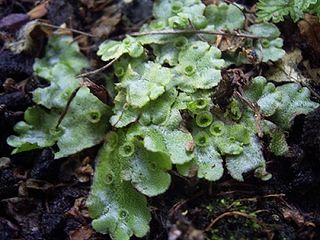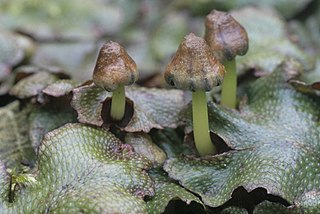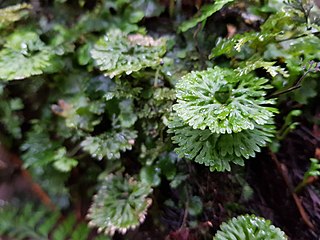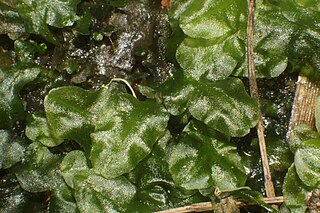
Anthocyanidins are common plant pigments, the aglycones of anthocyanins. They are based on the flavylium cation, an oxonium ion, with various groups substituted for its hydrogen atoms. They generally change color from red through purple, blue, and bluish green as a function of pH.

Bryophytes are a group of land plants, sometimes treated as a taxonomic division, that contains three groups of non-vascular land plants (embryophytes): the liverworts, hornworts, and mosses. In the strict sense, the division Bryophyta consists of the mosses only. Bryophytes are characteristically limited in size and prefer moist habitats although some species can survive in drier environments. The bryophytes consist of about 20,000 plant species. Bryophytes produce enclosed reproductive structures, but they do not produce flowers or seeds. They reproduce sexually by spores and asexually by fragmentation or the production of gemmae. Though bryophytes were considered a paraphyletic group in recent years, almost all of the most recent phylogenetic evidence supports the monophyly of this group, as originally classified by Wilhelm Schimper in 1879. The term bryophyte comes from Ancient Greek βρύον (brúon) 'tree moss, liverwort' and φυτόν (phutón) 'plant'.

The Marchantiophyta are a division of non-vascular land plants commonly referred to as hepatics or liverworts. Like mosses and hornworts, they have a gametophyte-dominant life cycle, in which cells of the plant carry only a single set of genetic information.

An antheridium is a haploid structure or organ producing and containing male gametes. The plural form is antheridia, and a structure containing one or more antheridia is called an androecium. Androecium is also the collective term for the stamens of flowering plants.

Marchantiales is an order of thallose liverworts that includes species like Marchantia polymorpha, a widespread plant often found beside rivers, and Lunularia cruciata, a common and often troublesome weed in moist, temperate gardens and greenhouses.

A gemma is a single cell, or a mass of cells, or a modified bud of tissue, that detaches from the parent and develops into a new individual. This type of asexual reproduction is referred to as fragmentation. It is a means of asexual propagation in plants. These structures are commonly found in fungi, algae, liverworts and mosses, but also in some flowering plants such as pygmy sundews and some species of butterworts. Vascular plants have many other methods of asexual reproduction including bulbils and turions.

Marchantia is a genus of liverworts in the family Marchantiaceae and the order Marchantiales.

Riccia is a genus of liverworts in the order Marchantiales.

Conocephalum is a genus of complex thalloid liverworts in the order Marchantiales and is the only extant genus in the family Conocephalaceae. Some species of Conocephalum are assigned to the Conocephalum conicum complex, which includes several cryptic species. Conocephalum species are large liverworts with distinct patterns on the upper thallus, giving the appearance of snakeskin. The species Conocephalum conicum is named for its cone-shaped reproductive structures, called archegoniophores. Common names include snakeskin liverwort, great scented liverwort and cat-tongue liverwort.

Hymenophyton flabellatum is a species of the order Pallaviciniales (liverworts), one of perhaps several species in the genus Hymenophyton. It is a dendroid thalloid liverwort belongs to the family Hymenophytaceae and is commonly known as Fan liverwort. It is found in New Zealand, Chile, and common in wet forests of Australia and Tasmania. Hymenophyton flabellatum closely resembles with small filmy fern, Hymenophyllum and can be confused with the liverwort, Symphyogyna hymenophyllum.

Marchantia polymorpha is a species of large thalloid liverwort in the class Marchantiopsida. M. polymorpha is highly variable in appearance and contains several subspecies. This species is dioicous, having separate male and female plants. M. polymorpha has a wide distribution and is found worldwide. Common names include common liverwort or umbrella liverwort.

Anthoceros agrestis, commonly called field hornwort, is a bryophyte of the family Anthocerotaceae.

Dihydrostilbenoids (bibenzyls) are natural phenols formed from the dihydrostilbene (bibenzyl) backbone.

Conocephalum conicum, also known as the great scented liverwort or snakeskin liverwort, is a liverwort species in the genus Conocephalum. C. conicum is part of the Conocephalum conicum complex, which includes several cryptic species. The name C. conicum refers to the cone-shaped archegoniophore, which bear sporangia.

Isoscutellarein is a flavone found in Cupuaçu and in the liverwort Marchantia berteroana.

Hypolaetin is a flavone. It is the aglycone of hypolaetin 8-glucuronide, a compound found in the liverwort Marchantia berteroana. Hypolaetin 8-glucoside can be found in Sideritis leucantha.

Asterella californica is a complex thallic liverwort in the phylum Marchantiophyta. A. californica often grows as colonies of flat rosettes of light green, rigid thalli, with undersides dark wine-red to nearly black. The receptacles are rounded, with four lobes each bearing a single sporangium sheathed by a white tattered skirt. A. californica is dioecious with separate male plants often intermingled with female plants. This species is found throughout California. See Distribution information below. Asterella californica is the commonest species of the three species of Asterella occurring in California; the other two species are A. bolanderi and A. palmeri.

Podomitrium phyllanthus is a thalloid liverwort in the family Pallaviciniaceae. It is found in wet forests and rainforests of Australia, New Zealand and New Caledonia.

The oil bodies of liverworts, occasionally dubbed complex oil bodies for distinction, are unique organelles exclusive to the Marchantiophyta. They are markedly different from the oil bodies found in other land plants and algae in that they are membrane-bound, and not associated with food storage. The organelles are variable and present in an estimated 90% of liverwort species, often proving taxonomically relevant. As a whole, the formation and function of the organelles are poorly understood. Complex oil bodies are recognized as sites of isoprenoid biosynthesis and essential oil accumulation, and have been implicated with anti-herbivory, desiccation tolerance, and photo-protection.

Monoclea forsteri is one of the two species in the thallose liverwort family Monocleaceae. It is dioicous with the capsule dehiscing with a single longitudinal slit. Endemic and widely distributed throughout New Zealand, it is also the country's largest thalloid liverwort. Hooker described the species in 1820. The holotype is in the British Museum.






















